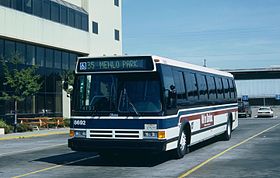Flxible Metro
| Flxible Metro/Grumman 870 | |
|---|---|

A Flxible Metro 40102-6C of Santa Clara County Transit (San Jose, California) in 1987
|
|
| Overview | |
| Manufacturer | Flxible |
| Production | 1978–1983 (as Grumman 870) 1983–1995 (as Flxible Metro) |
| Assembly | Delaware, Ohio |
| Powertrain | |
| Engine | Detroit Diesel or Cummins |
| Transmission | ZF, Voith, or Allison |
| Dimensions | |
| Length | 30 ft (9.14 m), 35 ft (10.67 m), or 40 ft (12.19 m) |
| Width | 96 in (2.44 m) or 102 in (2.59 m) |
| Height | 120 in (3.05 m) |
| Chronology | |
| Predecessor | Flxible New Look |
| Successor | None – (out of business) |
The Flxible Metro was a transit bus that was assembled and manufactured by the Flxible Corporation from 1983 until 1995. From 1978 until mid-1983, when Flxible was owned by Grumman, the model was known as the Grumman 870, with a Grumman nameplate. The model 870 experienced a number of major design defects and deficiencies, some of which led to the filing of lawsuits against the company by purchasers, and the successor "Metro" model addressed those design issues.
Over the combined 17-year production history, a total of 14,456 were built, of which 4,642 were model 870 and 9,814 were Metros.
Under the ownership of Rohr Industries since 1970, while their very popular Flxible New Look was still in production, Rohr began development of what would become the Grumman 870 Advanced Design Bus. The Grumman 870 bus was one of two advanced-design buses (the other being the Rapid Transit Series (RTS II) developed by rival General Motors and later taken by MTS). Both models were compromises by the Urban Mass Transit Administration (UMTA), which sought to develop a "Transbus" design that would be "attractive, roomy, comfortable", and easier for elderly and disabled customers to board, accepting these two models as compromises. At the time, the federal government would subsidize the purchase of only the 870 or the RTS II.
In 1978, Rohr sold Flxible to Grumman for US$55 million, with the sale including the sale of two prototypes of what would become the 870. In spite of the fact that the second prototype failed testing as the result of a cracked "A" frame, and with an endurance test not yet performed, Grumman decided that the 870 was ready for production, and discontinued the Flxible New Look almost as soon as the purchase closed (more in "Litigation resulting" below). The first 870 rolled off the assembly line in spring 1978. Under Grumman ownership, Grumman-Flxible (as the company was called at the time) received a major order of buses from the New York City Transit Authority along with other agencies. The NYC Transit Authority order, built in 1980, is notable because this batch would expose the design flaw in A-frame noted during testing: the inability of the bus to withstand wear and tear in cities where potholes were a problem, forcing all 870s built until that time to be taken out of service beginning that December while repairs to the A-frame were made, which would cost Grumman $7 million to fix. A total of 2,656 buses, including buses in Atlanta, Chicago, Connecticut Dept. of Transportation, Houston, and Los Angeles needed to be fixed.
...
Wikipedia
